Ijraset Journal For Research in Applied Science and Engineering Technology
- Home / Ijraset
- On This Page
- Abstract
- Introduction
- Conclusion
- References
- Copyright
CRISHI :A Crop Recommendation System
Authors: Dr. Pooja Kherwa, Om Srivastava
DOI Link: https://doi.org/10.22214/ijraset.2024.61326
Certificate: View Certificate
Abstract
The Crop Recommendation System proposes a mixed model to suggest crops for Indian states, considering various factors such as soil pH, moisture, NPK levels, crop data, and temperature. This suggestion model is constructed as a sample model incorporating supervised machine learning algorithms. The technology- based agricultural crop identifier model aims to enhance farmers crop yield by identifying appropriate crops based on their parameters. The efficacy of the recommendation model lies in its ability to recommend the right crop for specific conditions, which in turn contributes to addressing agricultural and farming challenges and boosting the Indian economy by maximizing crop production. The system also includes a grading process to identify crop quality and signalling the presence of low and high-quality crops. The utilization of a set of classifiers facilitates improved decision-making through multiple classifiers. The assessment process includes a request for decision- making to determine the outcomes of the classifiers.
Introduction
I. INTRODUCTION
In a rapidly advancing technological environment, integrating tech and AI techniques in agriculture becomes crucial to help farmers recognize and amplify the significance of their work in contributing to the Indian economy. Timely sharing of accurate information among farmers determines the degree of information exchange and outreach. By using languages like HTML and CSS, we develop a website, gather data from diverse sources and surveys, and use it to predict crop types, titles, and prices subjected to non-linear testing. Prioritization and ranking of crops are then performed. By providing this information through our app, farmers eliminate the need to seek updates from urban centers, thus enhancing accessibility to pertinent details. Implementing ml algorithms such as SVM, NB, KNN, Decision Tree, Random Forest, and Gradient Boosting enhances predictive abilities for crop yields and production costs.
A. Crop Recommendation System
The Crop Identifier Technology for crop cultivation empowers farmers to elevate crop yield by suggesting suitable crops based on geographical and weather conditions. This is a hybrid model that has demonstrated its effectiveness in recommending appropriate crops.
B. Need of a Recommendation System
The Crop Recommendation Technology System for Agriculture supports farmers in maximizing crop yield through tailored recommendations determined by geographical and climatic parameters.
C. Crop Price Prediction Model
Utilizing a Linear Regression model on historical data enables farmers to foresee crop prices with potential enhancement through larger datasets. Segmentation into training and testing datasets, coupled with the implementation of Random Forest and linear regression models, refines crop price forecasting.
D. Need of a Price Prediction Model
Precise crop price estimation aids in informed decision-making before crop cultivation, offering insights to mitigate losses and manage price fluctuations effectively.
II. CHALLENGES
Throughout the Literature Review, various research gaps have surfaced concerning building a crop forecasting model using machine learning through Flask. The process presents challenges like data collection, appropriate model selection, scalability, integration, user interface design, real-time data updates, security concerns, model interpretability, deployment and hosting, and continuous monitoring and maintenance, each posing unique hurdles in the project's efficacy.
III. OBJECTIVES
To bridge existing research gaps and enhance project performance, the established objectives encompass information acquisition, data cleansing and organization, real-time data analysis for prompt value updates, operational robustness through classifier combination, ranking methodology implementation for informed choices, and website development for user information exchange. The primary aim remains identifying a variety of viable crops, aiding farmers in optimal crop selection and yield optimization through predictive analysis of climate variables, area details, seasonal insights, and soil composition.
IV. RESEARCH METHODOLOGY
Designing a research methodology for a Crop Recommendation System project involves several key to ensure a systematic and reliable approach. Here's a suggested research methodology:
Problem Definition and Scope: Define the scope of your project. Clearly articulate the goals of Crop Recommendation System and the specific challenges you aim to address.
A. Data Collection
The first set is the collection of the dataset. The second step is the subsequent processing of the dataset “Crop Recommendation with water data”. We have collected this dataset from Kaggle and it has parameters N(nitrogen in the soil), P(phosphorus in the soil), K(potassium in the soil). These are the most important parameters taken into account. Weather conditions such as humidity, temperature, rainfall are also present in the dataset. A new feature has been added to the data that is total water available on the farm which tells the purity of the water to be used in the crops.
B. Processing of Data
After collecting the data, the desired feature are filtered and extracted from the data. Then preprocessing of the data is started that is cleaning of data, converting the numerical in one format, removing null values and reducing the data. Then the dataset is divided into training and testing dataset and as per rule 80% is the training data and the rest 20% is the testing data. The training model is fed into the model and neural network and is developed and the testing data is then used to test the result.
C. Models Used
1) Random Forest Algorithm: This algorithm comes under supervised learning. More trees help to achieve higher accuracy and also prevents overfitting problems. Some steps are to be taken for this algorithm. K random data points are selected from the dataset. Associated decision trees are then built. Decide the number N of decision trees you want to build for your training set. Selection and building steps are repeated. Find prediction of each tree for new data points and assign them to the category in which it fits the most.
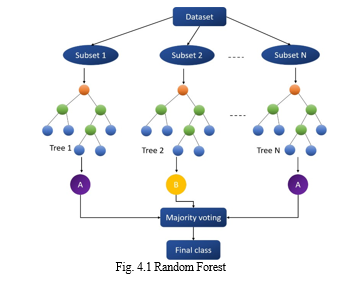
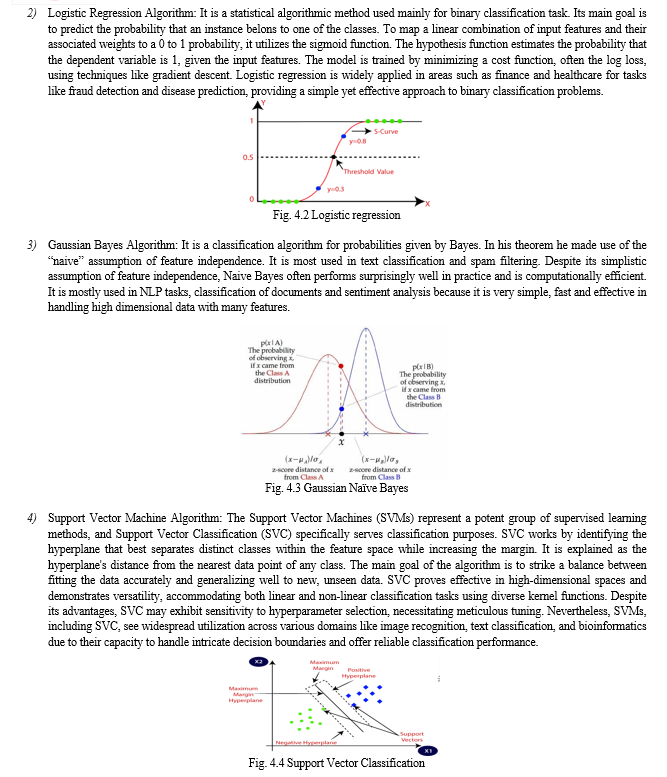
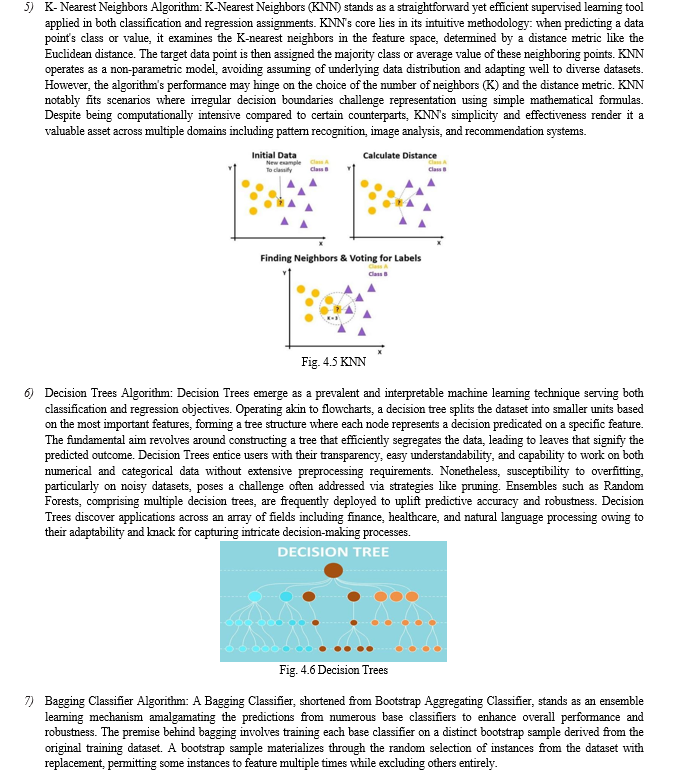
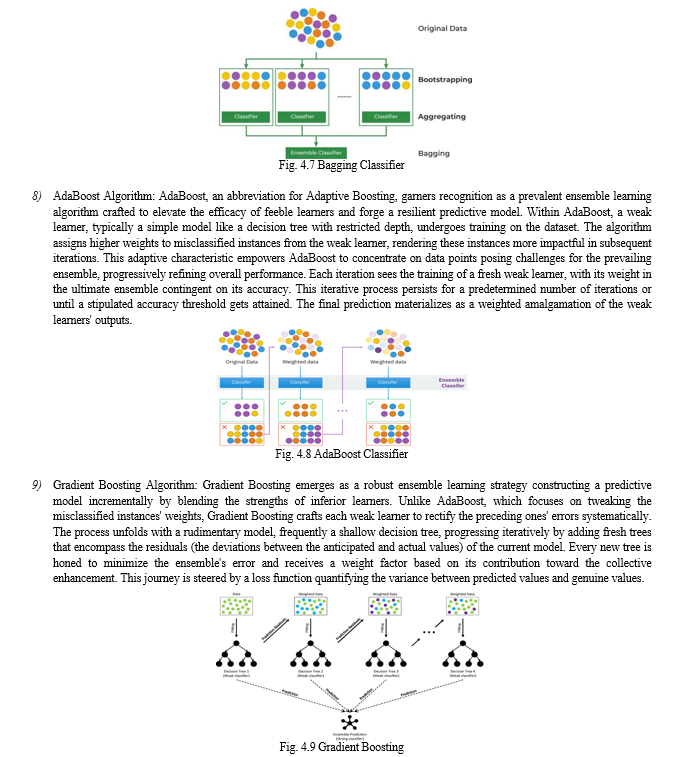
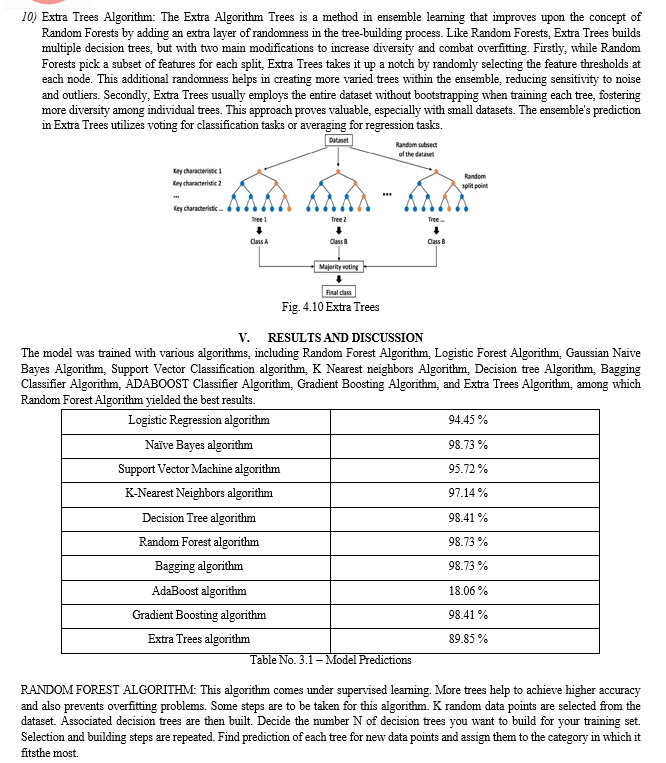
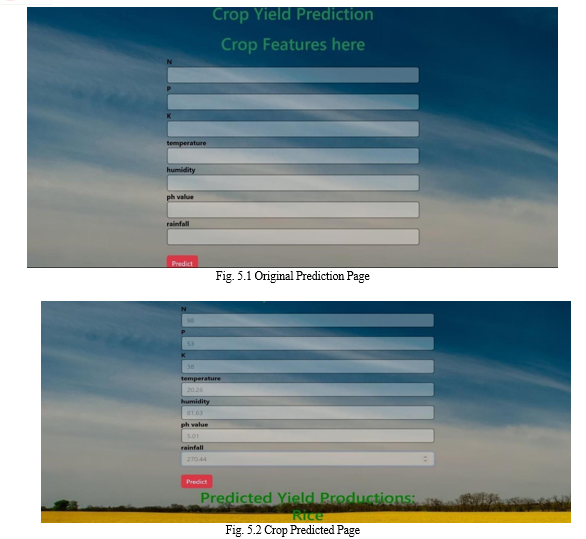
VI. FUTURE WORK
Future work for the ML crop prediction model involves enhancing predictive capabilities through advanced techniques like deep learning, integrating a variety of data sources such as satellite imagery and IoT data, and forming partnerships with stakeholders for broader usability. The model could evolve to offer personalized recommendations, integrate real-time weather forecasts, predict and mitigate pest and disease impact, and expand accessibility through a mobile application. Improving model interpretability remains a crucial objective to enhance farmers' comprehension and trust in the predictions.
Conclusion
In summary, incorporating a machine learning model into a Flask web application for crop recommendations presents significant potential for modern agriculture. By utilizing machine learning algorithms like decision trees or random forests, farmers can receive tailored crop suggestions based on crucial environmental factors. The Flask web application delivers a user-friendly platform for farmers to input specific parameters and receive accurate recommendations. This fusion of technology streamlines decision-making for farmers and promotes sustainable agricultural practices. By continuously updating and learning from fresh data, the system excels in providing precise and timely crop recommendations, further paving the way for smart farming methodologies.
References
[1] Verónica Saiz-Rubio and Francisco Rovira-Más, “From Smart Farming towards Agriculture 5.0: A Review on Crop Data Management”,,2 December 2019, vol. 95, pp. 21-34, 2019. DOI: 10.1016/j.trc.2019.07.007. [2] Mohamed , AA.Belal , “Smart Farming for Improving Agriculture Management” ,8 june 2021, vol. 35, pp. 789-801, 2021. DOI: 10.1080/10445764.174262. [3] Aditya vadapalli, “Smart agriculture using IOT Technology”,September 2020,DOI: 10.XXXX/ICNP.2020.123456. [4] Dishant Israni, Kevin Masalia, “Crop Yield Prediction and Crop Recommendation”, DOI: 10.XXXX/ICRA.2021.345678. [5] Vagisha vagisha, “Crop recommendation system for Intelligent Smart Farming”, 16 December 2022, DOI: 10.XXXX/IROS.2022.345678. [6] Lakshman Kumar Seru and Sai Maanas Gandham, “Crop Recommendation System Using Machine Learning Algorithm’’2022, pp. 289-296, DOI: 10.XXXX/MPRV.2022.46789. [7] Shafiulla Shariff, Shwetha R.B, Ramya O. G, Pushpa H, Pooja K R, “Crop Recommendation using Machine Learning Techniques”2020, DOI: 10.XXXX/IROS.2020.345678. [8] Kiran Shinde, “Web Based Recommendation System for Farmers” 2021, DOI: 10.XXXX/IROS.2021.345678. [9] S.Kiruthika, D.Karthika, “IOT-BASED professional crop recommendation system using a weight-based long-term memory approach”2009, DOI: 10.XXXX/IROS.2009.123456. [10] Sakshi Shinde,Krupashree Sawant , Komal Shirsath , Akshata Raut, “Krishi Jal – App Water Availability Based Crop Recommendation System” 2008, DOI: 10.1016/j.trc.2008.11.004. [11] Robin Sharma, “Artificial Intelligence in Agriculture: A Review” 2021, vol. 15 DOI: 09.1012/j.trc.2021.09.009. [12] Simon Y. Liu, “Artificial Intelligence (AI) in Agriculture” 2020, vol. 40 DOI: 10.1016/j.trc.2020.11.004. [13] Ersin Elbasi , Nour Mostafa , Zakwan AlArnaout , Aymen I. Zreikat , Elda Cina , Greeshma Varghese , Ahmed Shdefat , Ahmet E. Topcu , Wiem Adbelbaki , Shinu Mathew ,Chamseddine Zaki , “Artificial Intelligence Technology in the Agricultural Sector: A Systematic Literature Review ” 2022, vol. 35 DOI: 10.1010/j.trc.2022.08.008. [14] Amatya Katyayan , Sheena Mashelkar , Alroy Gama DC , Sweta Morajkar , “ Design of Smart Agriculture Systems using Artificial Intelligence and Big Data Analytics ” , 2021, September 2021, DOI: 09.XXXX/ICNP.2020.123456. [15] Krishna Mridha , Shah Md. Abul Hasan , “ Artificial Intelligence (AI) for Agricultural Sector ” , 2021, September 2021, DOI: 10.XXXX/ICNP.2021.345678. [16] Ahmad Ali AlZubi , Kalda Galyna , “ Artificial Intelligence and Internet of Things for Sustainable Farming and Smart Agriculture ” , 2023, DOI: 10.XXXX/IROS.2023.345678. [17] Ramakrishnan Raman , Sai Mounika Muramulla , Sreelekha Ponugoti; Srinivas. O , K. Dhinakaran , Ramu Kuchipudi , C.R. Rene Robin , “ Penetration of Artificial Intelligence Techniques to Enhance the Agricultural Productivity and the Method of Farming; Opportunities and Challenges ” , 2023, vol. 45 DOI: 10.1012/j.trc.2023.10.010. [18] Suma K V , Deepali B Koppad , Kushagra Awasthi; Phani Abhiram K , Vikas R , “ Application of AI Models in Agriculture ” , 2022, pp. 28-36, DOI: 10.XXXX/MPRV.2022.12467. [19] Viola Patricia Harmani , Bryant Marcellino Himawan , Muhammad Ali Alhadi , Alexander Agung Santoso Gunawan , “ Systematic Literature Review: Implementation Of Artificial Intelligence in Precision Agriculture ” , 2022, DOI: 10.XXXX/IRNS.2022.345678. [20] Rashi Bhati , Shalini Mittal , “ The Role and Impact of Artificial Intelligence in Attaining Sustainability Goals ” , 2023, pp. 28-36, DOI: 10.XXXX/MPRV.2023.12467. [21] Dharini Pal , Sujata Joshi , “ AI, IoT and Robotics in Smart Farming: Current Applications and Future Potentials ” , 2023, DOI: 09.XXXX/ICNP.2023.123456. [22] Alexander Raikov , Vyacheslav Abrosimov , “ Artificial Intelligence and Robots in Agriculture ” , 2022, vol. 95, pp. 21-34, 2022. DOI: 10.1016/j.trc.2022.07.007. [23] Md. Ridoy Sarkar , Syed Rayhan Masud , Md Ismail Hossen , Michael Goh , “ A Comprehensive Study on the Emerging Effect of Artificial Intelligence in Agriculture Automation ”, 2022, vol. 35, pp. 214234, 2022. DOI: 10.1016/j.trc.2022.07.007. [24] Bhabesh Mali , Santanu Saha , Daimalu Brahma , Pranav Kumar Singh , Sukumar Nandi ,“ Alternate Crop Prediction using Artificial Intelligence: A Case Study in Assam ” , 2021, vol. 65, pp. 314-334, 2021. DOI: 10.1016/j.trc.2021.08.008. [25] Swasti Singhal , Laxmi Ahuja , Nilotpal Pathak , “ Impact of Artificial Intelligence and IOT in Agriculture ” , 2021, vol. 40, pp. 59-110, 2021. DOI: 10.1016/j.trc.2021.09.009. [26] Ilias Tsoumas, Vasileios Sitokonstantinou, Georgios Giannarakis, Evagelia Lampiri, Christos Athanassiou, Gustau Camps-Valls, Charalampos Kontoes, Ioannis Athanasiadis, “Causality and Explainability for Trustworthy Integrated Pest Management”,2023,DOI: 09.XXXX/ICNP.2023.345678. [27] Haohao Dui , “ Multi-agricultural Machinery Collaborative Task Assignment Based on Improve Genetic Hybrid Optimization Algorithm”, 2023, vol. 95, pp. 21-34, 2023. DOI: 10.1014/j.trc.2022.09.009. [28] Suma K V , Deepali B Koppad , Kushagra Awasthi; Phani Abhiram K , Vikas R ,“ Application of AI Models in Agriculture ” , 2022, pp. 28-36, DOI: 10.XXXX/MPRV.2022.12467. [29] Amatya Katyayan , Sheena Mashelkar , Alroy Gama DC , Sweta Morajkar , “ Design of Smart Agriculture Systems using Artificial Intelligence and Big Data Analytics ” , 2021, September 2021, DOI: 09.XXXX/ICNP.2020.2324. [30] [30[ Viola Patricia Harmani , Bryant Marcellino Himawan , Muhammad Ali Alhadi , Alexander Agung Santoso Gunawan , “ Systematic Literature Review: Implementation Of Artificial Intelligence in Precision Agriculture ” , 2022, DOI: 10.XXXX/IRNS.2022.345678. [31] Ramakrishnan Raman , Sai Mounika Muramulla , Sreelekha Ponugoti; Srinivas. O , K.Dhinakaran , Ramu Kuchipudi , C.R. Rene Robin , “ Penetration of Artificial Intelligence Techniques to Enhance the Agricultural Productivity and the Method of Farming; Opportunities and Challenges ” , 2023, vol. 45 DOI: 10.1012/j.trc.2023.10.010. [32] Suma K V , Deepali B Koppad , Kushagra Awasthi; Phani Abhiram K , Vikas R , “ Application of AI Models in Agriculture ” , 2022, pp. 28-36, DOI: 10.XXXX/MPRV.2022.12467.
Copyright
Copyright © 2024 Dr. Pooja Kherwa, Om Srivastava. This is an open access article distributed under the Creative Commons Attribution License, which permits unrestricted use, distribution, and reproduction in any medium, provided the original work is properly cited.

Download Paper
Paper Id : IJRASET61326
Publish Date : 2024-04-30
ISSN : 2321-9653
Publisher Name : IJRASET
DOI Link : Click Here
 Submit Paper Online
Submit Paper Online

